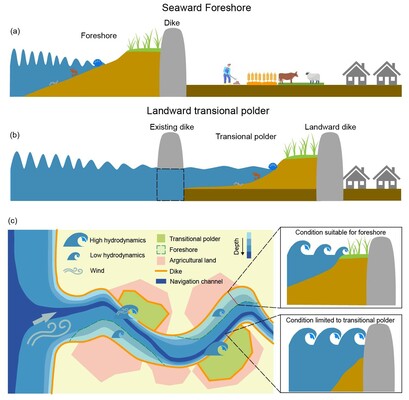Xuerong Wu1,2,*, Tjeerd J. Bouma1,2,3, Francesco Cozzoli4, Johan van de Koppel1,5, Jim van Belzen1,6
1 Department of Estuarine and Delta Systems, NIOZ Royal Netherlands Institute for Sea Research, Yerseke, the Netherlands; 2 Department of Physical Geography, Faculty of Geosciences, Utrecht University, Utrecht, The Netherlands; 3 Delta Academy Applied Research Centre, HZ University of Applied Sciences, Vlissingen, The Netherlands; 4 Laboratory of Ecology, Department of Biological and Environmental Sciences and Technologies, University of Salento, Lecce, Italy; 5 Groningen Institute for Evolutionary Life Sciences, Community and Conservation Ecology Group, University of Groningen, Groningen, The Netherlands; 6Wageningen Marine Research, Yerseke, the Netherlands
* Corresponding author: xuerong.wu@nioz.nl
Introduction
Nature-based Solutions (NbS), integrating ecosystems and natural processes, offer a promising approach to deliver benefits to both ecosystems and human society. In estuarine and coastal regions, highly vulnerable to storm surges and large waves exposures, NbS schemes are often primarily evaluated for flood risks (Duarte et al., 2013; Möller et al., 2014; Zhu et al., 2020). Comprehensive assessments of their broader impacts on biodiversity are frequently overlooked.
Objective and Methods
This study presents an integrated modelling approach to compare the long-term estuarine biodiversity outcomes of two nature-based coastal protection schemes: (i) a seaward foreshore and (ii) a landward transitional polder (i.e., a temporary de-embankment aimed at raising the land before returning it to agriculture). These schemes involve the creation of coastal wetlands, each subjected to different environmental and landscape settings.
Results
Our findings demonstrate that the two NbS schemes initially offer different benefits for biodiversity and ecosystem functions. However, the biodiversity effects converge over time due to accretion, making both solutions largely comparable in terms of long-term biodiversity outcomes. As the long-term biodiversity development is strongly influenced by the rate of sea level rise and available suspended sediment, these drivers may ultimately determine the NbS-selection and their objectives. Given practical constraints on implementing seaward foreshores due to hydrodynamic forces and societal constraints to land use changes for implementing transitional polders, the choice between alternative NbS often depends on factors beyond biodiversity alone. Yet, the rotational strategy of transitional polders offers a broader nature-based solution to the problem of salinization, which threatens the long-term viability of agriculture due to land subsidence. Scaling up implementation of transitional polders across estuaries using spatial planning and phased tidal exposure need to be aligned across regional agricultural and ecological objectives to optimize trade-offs and ensure social acceptance. Here we provide an essential toolset, offering ecological insights to optimize design of future NbS, thereby aiding policymakers and conservation planners in decision making.

A conceptual illustration of two nature-based coastal protection schemes. (a) The seaward foreshore involves developing a saltmarsh in front of existing dikes to enhance coastal protection. (b) The landward transitional polder scheme involves creating a transitional polder between double dikes, which can act as a buffer and contribute to flood defense. (c) Feasibility of foreshore and transitional polder. In areas with gentle slope gradients and low hydrodynamic forces, seaward schemes such as foreshores are more feasible as these conditions allow marshes to develop naturally and thrive (top right). Conversely, in regions near deep navigation channels with steep gradients and strong hydrodynamic forces which may further intensified by wind-induced waves (as depicted in the left high hydrodynamics area), seaward marsh establishment is considerably more challenging or impossible (bottom right). In such high-energy environments, landward schemes, like transitional polders, are the only option for reliable nature-based coastal protection. Here, dikes can be (temporarily) breached by constructing a tidal inlet, to convert agricultural land (temporarily) into tidal wetlands, offering a viable alternative for marsh creation in areas where direct seaward approaches are less/not effective.
References
Duarte, C. M., Losada, I. J., Hendriks, I. E., Mazarrasa, I., & Marbà, N. (2013). The role of coastal plant communities for climate change mitigation and adaptation. Nature climate change, 3(11), 961-968.
Möller, I., Kudella, M., Rupprecht, F., Spencer, T., Paul, M., Van Wesenbeeck, B. K., ... & Schimmels, S. (2014). Wave attenuation over coastal salt marshes under storm surge conditions. Nature Geoscience, 7(10), 727-731.
Zhu, Z., Vuik, V., Visser, P. J., Soens, T., van Wesenbeeck, B., van de Koppel, J., ... & Bouma, T. J. (2020). Historic storms and the hidden value of coastal wetlands for nature-based flood defence. Nature Sustainability, 3(10), 853-862.










